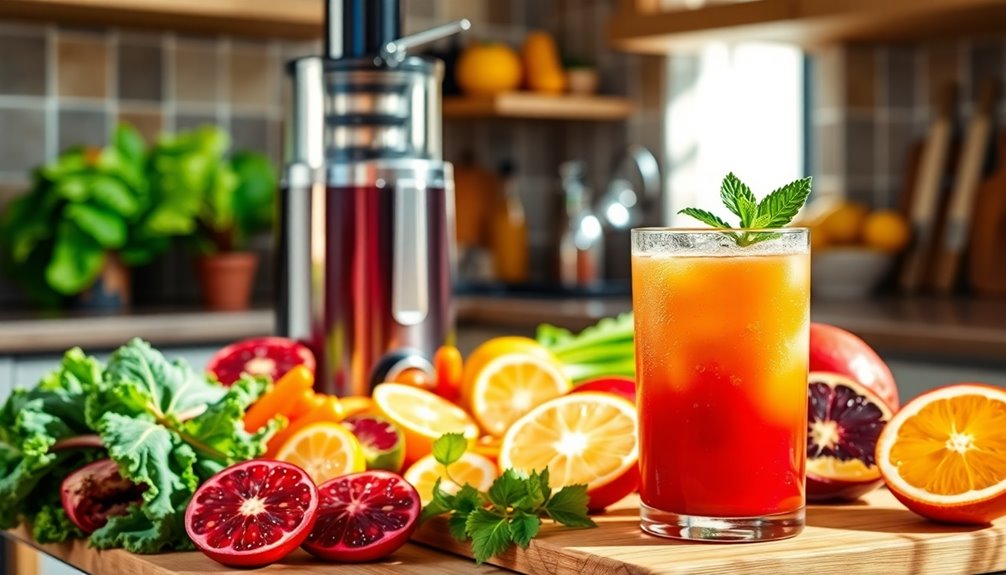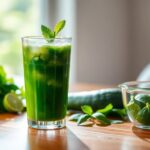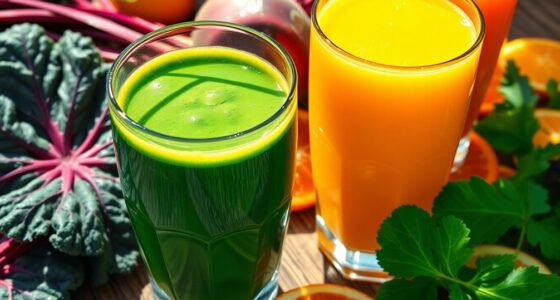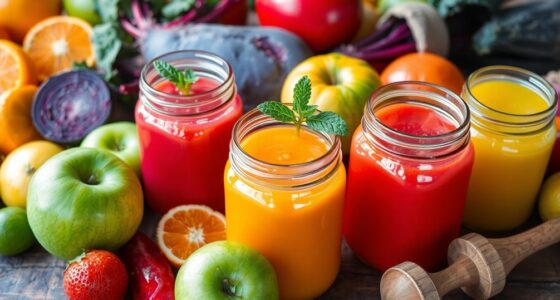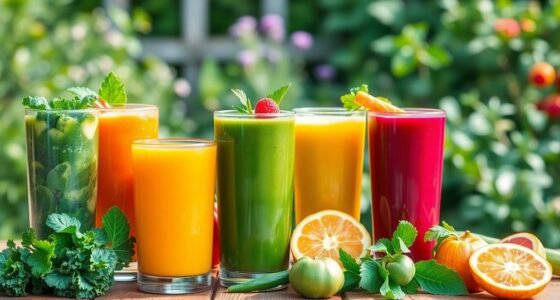To prepare organic juices at home like a pro, start by choosing high-yield fruits and nutrient-rich veggies, aiming for a 70% veggie to 30% fruit ratio. Select the right juicer based on your needs—masticating for nutrients, centrifugal for speed. Wash all ingredients thoroughly, then experiment with delicious recipes like green juice with kale and apple. Drink your juice fresh for maximum benefits and flavor. There's so much more to explore for perfecting your juicing journey!
Key Takeaways
- Select high-yield organic fruits and nutrient-rich vegetables for flavorful and healthful juices, aiming for a 70% vegetable to 30% fruit ratio.
- Choose the right juicer based on your needs; consider masticating for nutrient preservation and centrifugal for quick results.
- Wash all ingredients thoroughly to remove dirt and pesticides before juicing to ensure a clean and safe drink.
- Experiment with various combinations of fruits, vegetables, and herbs for unique flavors and enhanced nutritional benefits.
- Drink juices fresh for maximum taste and nutrition, and store any leftovers properly in airtight containers.
Essential Ingredients and Preparation Techniques
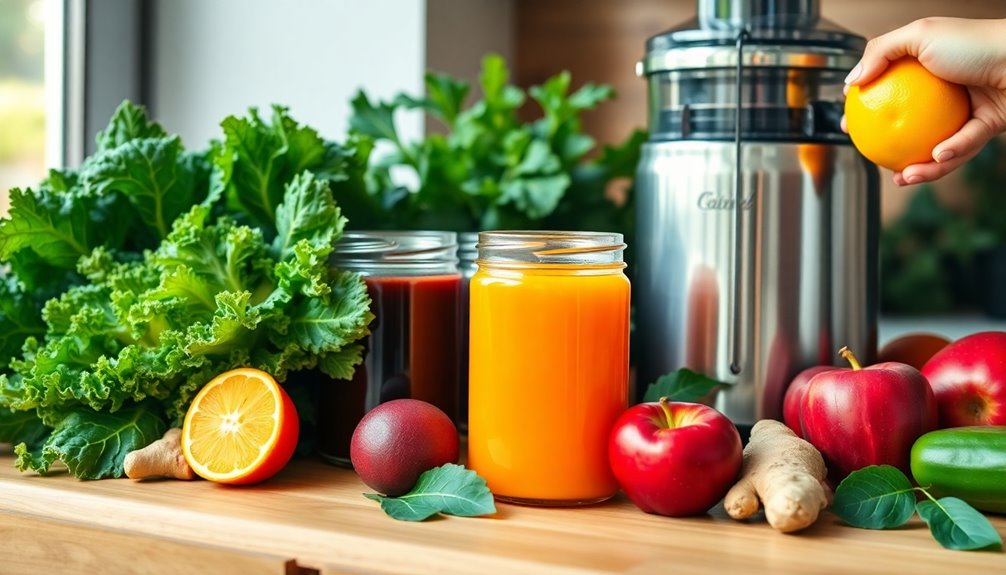
When you prepare organic juices at home, choosing the right ingredients and mastering preparation techniques are crucial for the best results. By selecting fresh, seasonal fruits and vegetables, you can enhance the flavors and nutritional benefits of your drinks. Experimenting with different combinations will not only keep your palate excited but also help you discover your favorite blends. For those seeking inspiration, there are countless homemade organic juice recipes available that can guide you through the process of creating delicious and healthy beverages.
Start with fruits like apples, pears, and pineapples, which yield a lot of juice. For veggies, include beetroot, carrots, and leafy greens like kale. Beet juice(improves blood flow) contains high levels of nitrates that can enhance overall health. Don't forget herbs and spices like ginger or turmeric for added flavor and health benefits. Using organic ingredients in your juicing not only enhances the flavor but also increases the nutrient content of your drinks.
Wash all your ingredients thoroughly to remove any dirt or pesticides, especially if they're not organic. Peel when necessary, particularly for bitter vegetable skins. Chop everything into manageable pieces for your juicer.
Aim for a 70% vegetable to 30% fruit ratio for balanced flavors, and enjoy the burst of nutrients in your homemade juices!
Selecting the Right Juicer for Your Needs
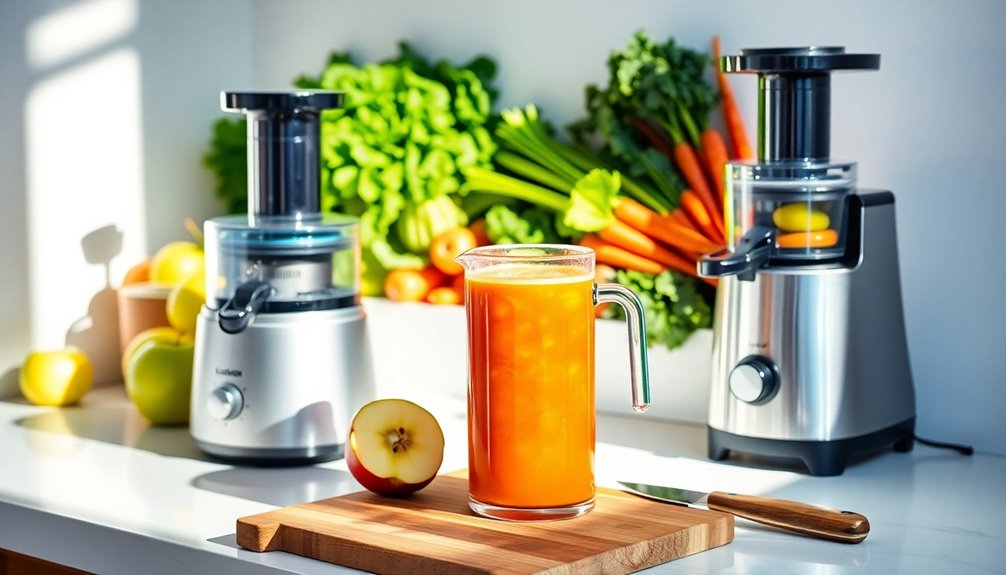
Choosing the right juicer can significantly impact the quality and enjoyment of your homemade organic juices.
Start by determining your juicing needs. If you love leafy greens, consider a masticating or twin gear juicer, as they excel in extracting nutrients. For quick juice, a centrifugal juicer may be your go-to, but be aware it can generate heat. Cold press juicers preserve flavor and nutrients, making them ideal for health-conscious juicers. Think about features like chute size for less prep time, ease of cleaning, and noise levels for your convenience. Incorporating a variety of fruits and vegetables, such as organic produce, can enhance the nutritional value of your juices.
Finally, balance your budget with brand reputation—options like AMZCHEF for budget-friendly choices or Kuvings for high-end quality ensure you find the perfect fit.
Delicious Organic Juice Recipes to Try
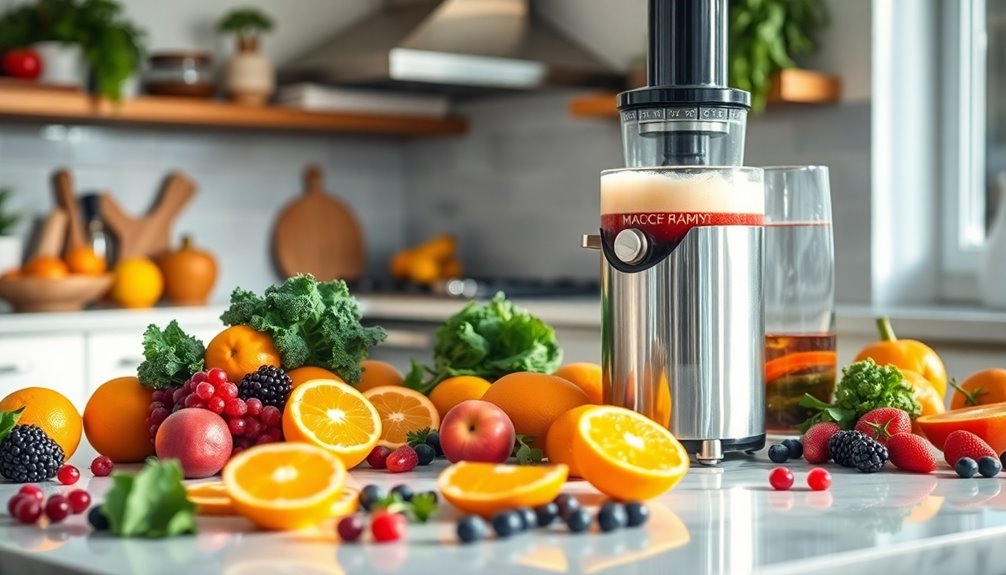
Exploring a variety of delicious organic juice recipes can elevate your home juicing experience, making it both enjoyable and nutritious. Try an orange-based juice with carrots, nectarines, apples, lemon, and ginger for a refreshing start, as this combination is not only packed with vitamins but also hydrating. Additionally, using fresh ingredients enhances both flavor and nutrition. For a detox boost, mix white grapes, kiwi, strawberries, and lemon into a berry lemon juice. Hydrate with apple melon juice featuring bok choy and celery. A post-workout favorite is tomato grape juice, combining cherry tomatoes, red grapes, and lemon. If you're feeling adventurous, whip up a green juice with kale, celery, apple, lemon, and ginger. Lastly, for a spicy twist, blend basil, white grape, pineapple, and spinach. Each recipe offers a unique flavor while keeping your health in focus!
Health Benefits of Incorporating Juices Into Your Diet
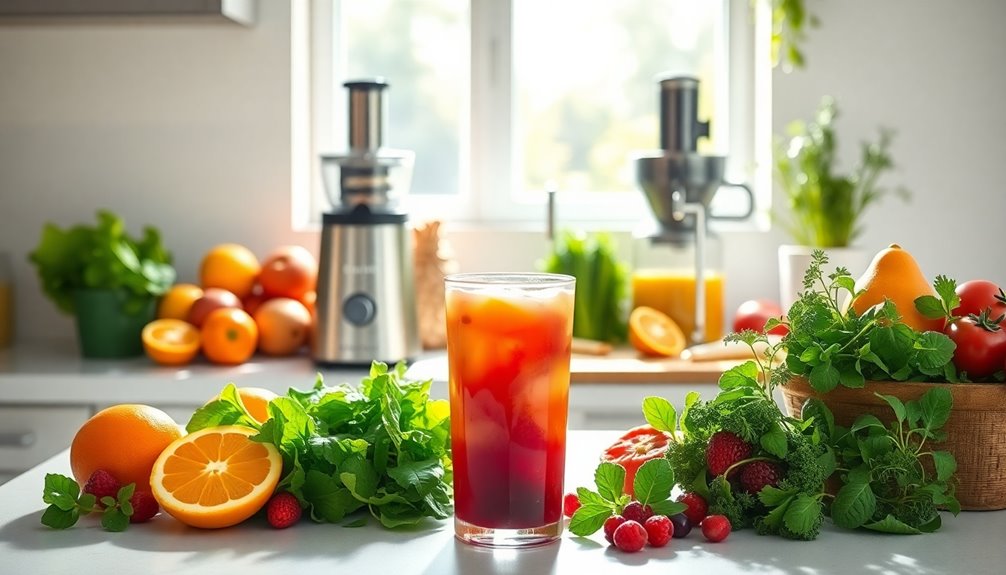
Incorporating organic juices into your diet can significantly enhance your overall health. These nutrient-dense beverages pack essential vitamins and minerals in a convenient form, making it easy to boost your intake. With 20-40% more antioxidants than conventionally grown produce, organic juices help neutralize free radicals, supporting your immune system and reducing cancer risk. High vitamin C levels promote skin health, while minerals found in these juices contribute to your body's overall function. Additionally, organic juices provide naturally occurring vitamins that further support your health and well-being. Juicing also aids digestion, allowing for better nutrient absorption, and incorporating juices like celery juice can further enhance hydration and support fetal development for pregnant women. Plus, the hydration from organic juices keeps you energized and helps with weight management.
Tips for Beginners: Getting Started With Juicing
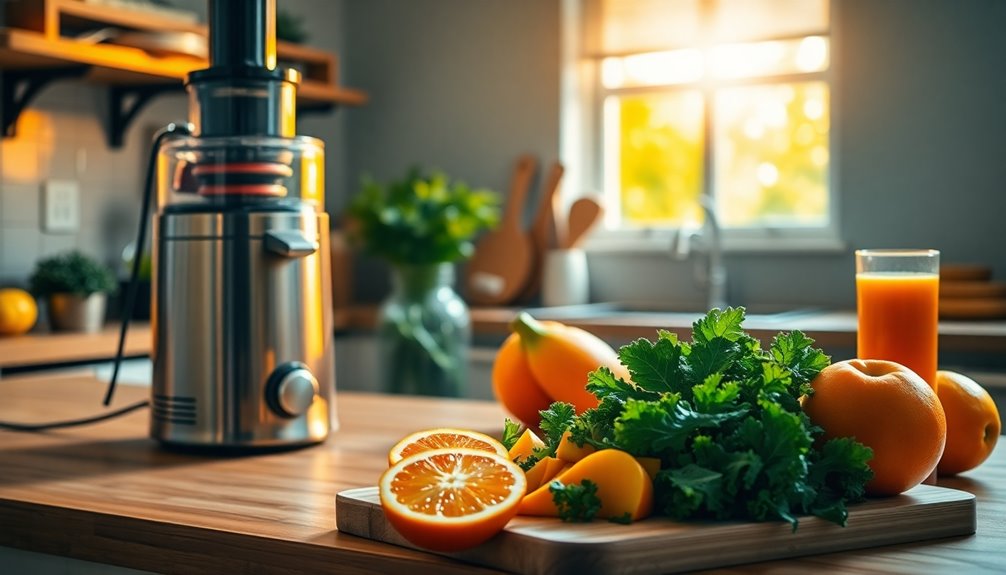
If you're eager to dive into the world of juicing, starting with a few simple tips can make the process enjoyable and rewarding.
First, choose the right juicer. A centrifugal juicer is budget-friendly but may struggle with leafy greens. For better nutrient preservation, consider a masticating or cold-press juicer. Masticating juicers lead to less oxidation and longer-lasting taste, making them a great investment for juice enthusiasts. Additionally, using a juicer that minimizes oxidation can help maintain the nutritional benefits of your ingredients.
Next, understand your ingredients. Combine sweet fruits like apples and tart options like lemons for a balanced flavor. Use high-yield ingredients like cucumbers for more juice.
Always read your juicer's manual to learn about its features. Start with a base of high-water-content fruits, and don't hesitate to experiment with different recipes. Remember that certain fruits and vegetables, like beets, should be consumed in moderation to avoid digestive issues.
Lastly, drink your juice fresh for maximum taste and nutrition. Enjoy the journey!
Proper Safety and Hygiene Practices
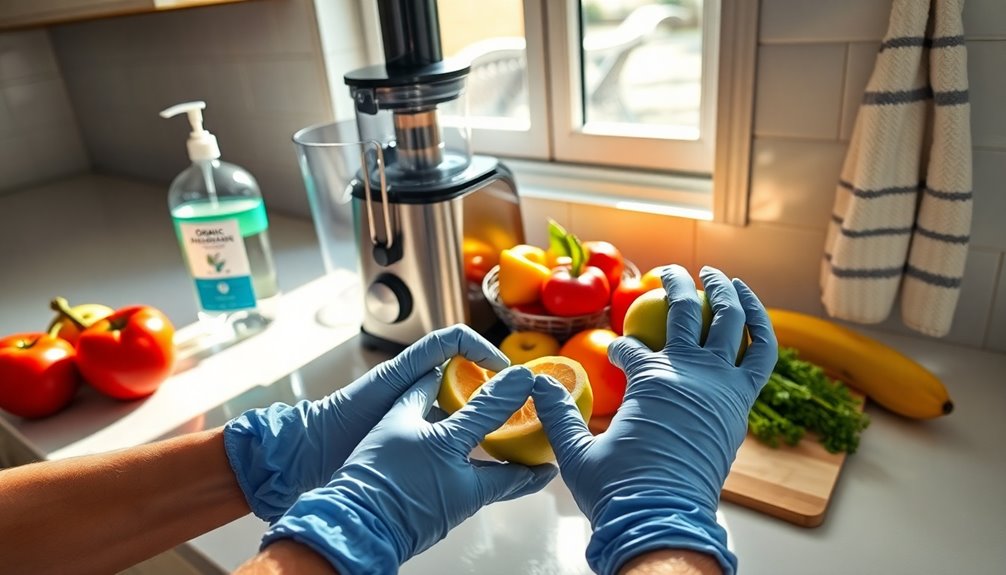
Maintaining proper safety and hygiene practices is crucial when preparing organic juices at home. Start by washing all fruits and vegetables thoroughly in clean water to reduce bacterial contamination. For extra cleanliness, consider using an antimicrobial wash or a baking soda solution. Remove any large seeds and pits to avoid bitterness and protect your juicer. It's essential to be aware that contaminated produce can lead to foodborne illnesses, so ensure you handle everything with care.
When it comes to peeling, assess whether it affects flavor or nutrients. Cut larger produce into smaller pieces for easier processing.
Ensure all juicing equipment is washed and sanitized to prevent cross-contamination. Regularly maintain your juicer, checking for damage before use.
Finally, store your equipment in a clean, dry area to inhibit bacterial growth and promote safety in your juicing process.
How to Store Your Juice for Maximum Freshness
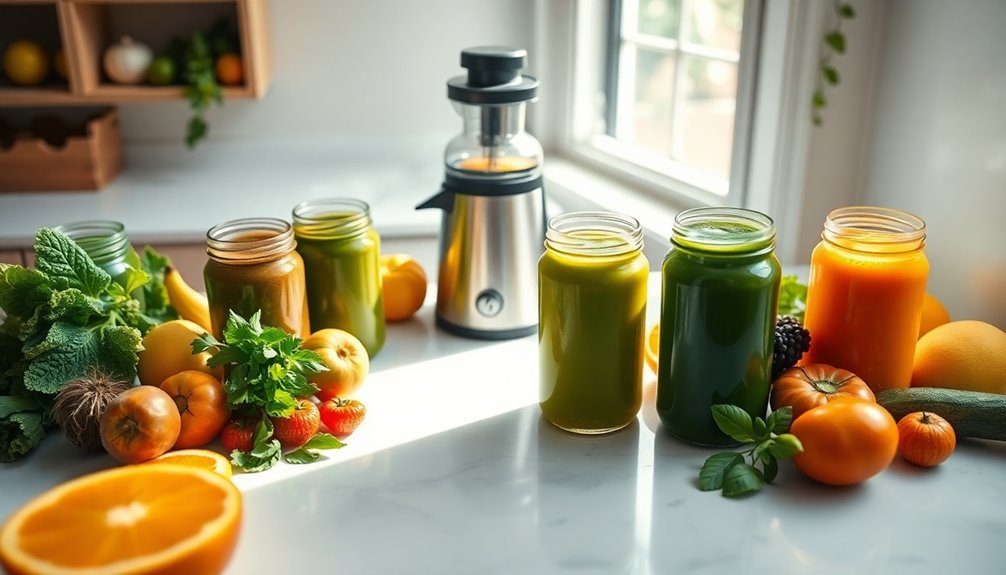
After ensuring your juicing process is safe and hygienic, knowing how to store your juice is key to preserving its freshness and nutrients.
Use a cold-press juicer to minimize heat and oxidation, which helps retain more nutrients. Store your juice in airtight glass containers to limit oxygen exposure, as plastic can accelerate nutrient loss. Fresh produce has lower enzyme reactions, leading to longer shelf life, making it essential to start with the best ingredients. Additionally, maintaining proper indoor air quality can enhance your overall juicing experience by ensuring a clean environment for your preparation.
Refrigerate your juice at 35-40°F (1.6-4.4°C) for optimal freshness, and consider freezing small portions in glass or silicone trays to extend shelf life.
For added preservation, remove excess oxygen from the container and consider adding a splash of lemon juice for its natural preservative qualities.
Regularly check for spoilage indicators like taste changes or separation to ensure quality.
Creative Ways to Enhance Flavor With Herbs
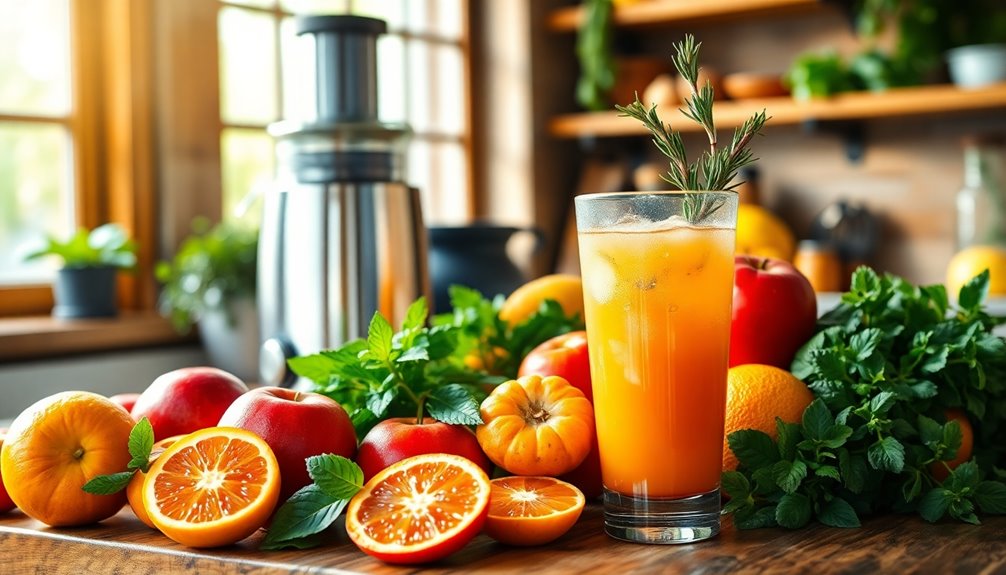
Enhancing the flavor of your organic juices with herbs can elevate your drink from ordinary to extraordinary.
Start by experimenting with creative combinations like basil and strawberries for a refreshing twist or cilantro with pineapple for a sweet, citrusy blend that aids digestion. Basil is an excellent source of antioxidants and can add depth to your juice. Additionally, using essential oils for hair growth can provide further benefits to your overall health and wellness.
Lavender paired with blueberries offers floral notes and antioxidants, while lemon balm with strawberries creates a light summer drink.
For a cooling effect, try mint and cucumber.
Remember to start with small amounts, as herbs can be potent.
Fresh herbs provide the best flavor, so opt for those when possible.
Don't hesitate to mix and match to discover unique flavor profiles that suit your taste.
Enjoy the process and savor the delightful results!
Understanding Nutrient Preservation in Juicing
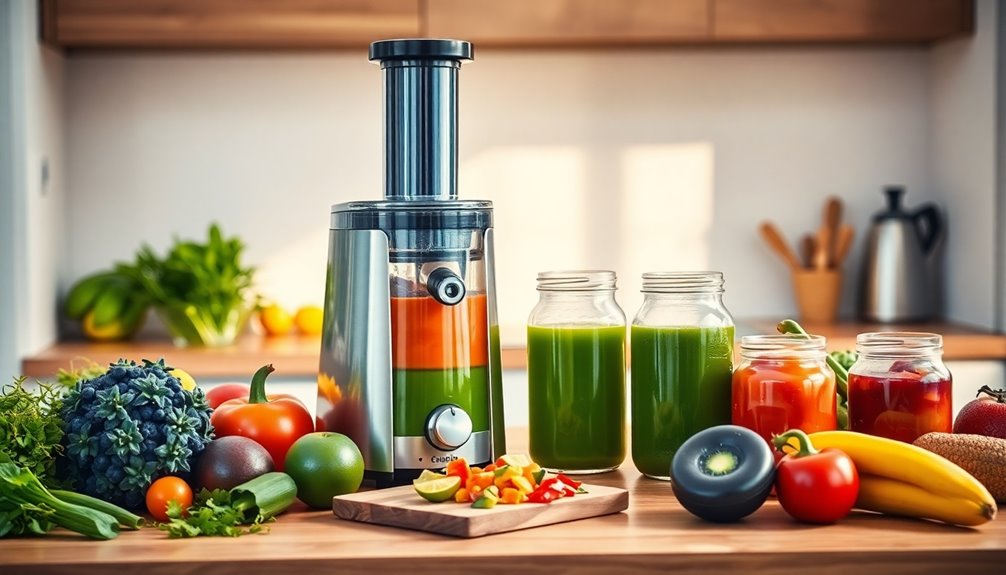
When you juice at home, understanding how to preserve nutrients is crucial for maximizing the health benefits of your drinks. One effective method is cold-pressing, which minimizes heat and reduces oxidation, keeping heat-sensitive vitamins and enzymes intact. Using chilled ingredients helps maintain nutrient integrity throughout the juicing process. Opt for organic produce, as it typically has higher nutritional content and fewer contaminants. Additionally, it's important to remove large seeds to avoid bitterness and protect your juicer's blades. Proper storage plays a vital role too; keep your juice in airtight containers at low temperatures to extend its shelf life and preserve nutrients. Incorporating advanced technology can also enhance the juicing process and improve overall efficiency.
Common Mistakes to Avoid When Juicing at Home
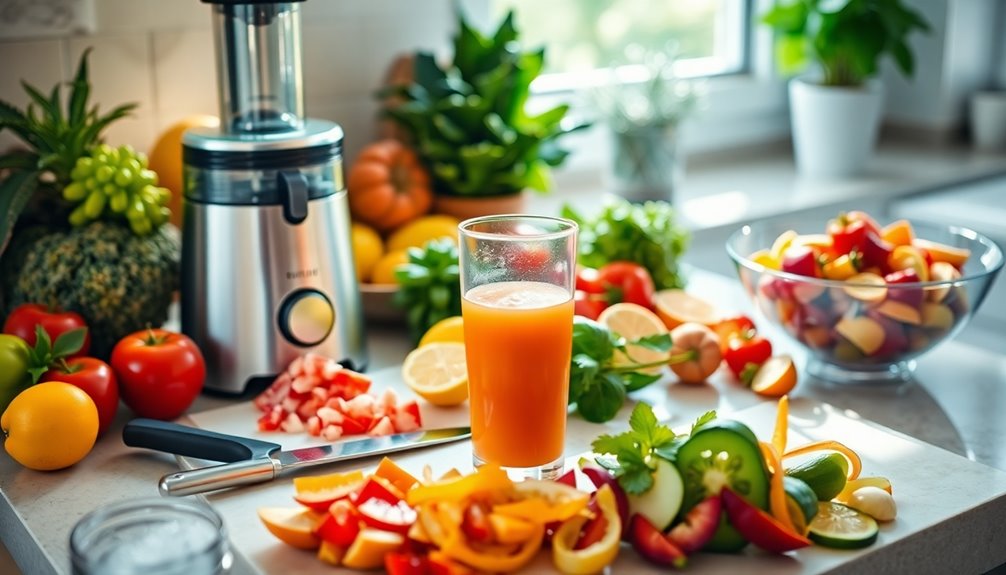
Juicing at home can be a rewarding experience, but it's easy to make mistakes that can compromise the quality of your drinks.
First, choose the right juicer—masticating juicers extract more nutrients than centrifugal ones. Be mindful of your ingredients' order; alternating them prevents clogging. Overloading your juicer can damage it, so feed ingredients gradually. Choosing the right juicer type is essential for optimal juice quality. Additionally, using fresh ingredients ensures the best flavor and maximum nutritional benefits.
Don't ignore leafy greens; they boost nutritional value significantly. Balancing flavors is key, so mix sweet, tart, and earthy components.
Always wash your produce thoroughly and chop them into manageable pieces to avoid issues. Store your juice properly if you can't consume it right away to maintain its nutritional benefits.
Lastly, clean your equipment regularly to avoid bacterial growth.
Frequently Asked Questions
Can I Mix Different Types of Fruits and Vegetables in One Juice?
Absolutely, you can mix different types of fruits and vegetables in one juice!
Combining them enhances nutritional balance, flavor, and freshness. Start with a base of leafy greens or mild vegetables like carrots, then add fruits for sweetness.
Aim for a ratio of 60-85% vegetables to 15-40% fruits for optimal taste.
Don't hesitate to experiment with various combinations; you'll discover unique flavors that suit your palate and nutrition needs perfectly!
How Do I Know if My Juice Has Gone Bad?
Your juice can turn from vibrant nectar to a murky swamp faster than you can say "freshly squeezed."
To know if it's gone bad, check for color changes—like green turning brown.
Smell it; a sour odor's a big red flag.
Taste a tiny sip; if it's bitter, toss it.
Look for any mold or sediment; those are definite signs of spoilage.
Trust your senses, and when in doubt, don't drink it!
Is It Necessary to Peel All Fruits Before Juicing?
It's not necessary to peel all fruits before juicing. Many fruits, like apples and grapes, have nutritious peels that enhance flavor and health benefits.
However, some peels, such as those from citrus fruits or mangoes, can be tough or bitter, so peeling them is a good idea.
Always wash your fruits thoroughly to remove dirt and pesticides, and consider using organic produce to ensure you minimize chemical exposure.
Can I Juice Frozen Fruits and Vegetables?
Yes, you can juice frozen fruits and vegetables, but make sure to thaw them first.
Using a cold press juicer is your best bet, as centrifugal juicers can't handle thawed produce effectively.
Keep in mind that thawed fruits may be softer, which can make juicing easier.
Just watch out for freezer burn, as it can affect the flavor.
Adding a bit of lemon or lime can help improve taste if needed.
How Often Should I Clean My Juicer?
You should clean your juicer after every use to prevent pulp buildup and bacterial growth.
If you wait, residue can dry, making it harder to clean later.
It's also wise to perform a thorough cleaning at the end of the day if you're using a commercial juicer.
Additionally, aim for a deep clean weekly or bi-weekly to keep everything running smoothly and to extend your juicer's lifespan.
Regular checks for wear are essential too.
Conclusion
Juicing at home is like planting a seed in your health garden. Each vibrant bottle of juice you create symbolizes a commitment to nourishing your body and embracing wellness. As you explore flavors and techniques, remember that every sip is a step toward vitality. With practice, you'll cultivate not just delicious juices, but also a deeper connection to your food and health. So, grab your juicer and start this flavorful journey, nurturing both your body and spirit one glass at a time.
Cindy thoroughly researches juicing trends, techniques, and recipes to provide readers with practical advice and inspiration. Her writing style is accessible, engaging, and designed to make complex concepts easy to understand. Cindy’s dedication to promoting the advantages of juicing shines through her work, empowering readers to make positive changes in their lives through the simple act of juicing.

